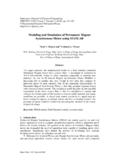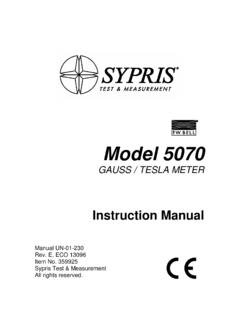Transcription of Over current and over voltage protection of …
1 IOSR Journal of Electrical and Electronics Engineering (IOSR-JEEE). e-ISSN: 2278-1676,p-ISSN: 2320-3331, Volume 9, Issue 5 Ver. III (Sep Oct. 2014), PP 79-86. over current and over voltage protection of permanent magnet brushless dc motor using wavelet analysis Valluru Hemanth Kumar1, 1. (EEE Department, Prasad V. Potluri Siddhartha Institute of Technology, India). 2. (EEE Department, Prasad V. Potluri Siddhartha Institute of Technology, India). Abstract: The objective of this paper is to develop over current and over voltage protection of permanent magnet Brushless DC Motor (PMBLDCM) using Wavelet Analysis. The Motor's operating point is continuously changing with time and the motor is never operating at a constant speed throughout its operation. A Motor operating in a non-stationary environment has a non-stationary voltage and current signals.
2 Fourier Transform (FT) cannot be used for analysis of non-stationary signals, because FT tells about which frequency components exist in the signal, but gives no time information about these frequency components. Short-Time Fourier Transform (STFT) was developed to solve this problem. STFT used a window function to view a part of non stationary signal as stationary and then perform analysis. However, STFT can have either good time resolution or good frequency resolution, but not both. Wavelet Transform was developed to overcome this resolution problem. Wavelet Analysis uses contracted and expanded versions of a single prototype function called a wavelet. Fine time resolution can be achieved using contracted version of the wavelet and fine frequency resolution can be achieved using expanded version.
3 Daubechies4 wavelet is chosen for this application. Keywords: PMBLDCM, Wavelet, Daubechies4, over current , over voltage . I. INTRODUCTION. 1. PMBLDCM. Brushless Direct current (BLDC) Motors are one of the motor types rapidly gaining popularity in industries, traction, and electrical vehicles. BLDC Motor has a rotor with permanent magnet and stator with windings. As the name implies, BLDC Motors do not use brushes for commutation; instead, they are electronically commutated. With availability of efficient semiconductor switches, mechanical switching on commutator machines is eliminated. BLDC Motor control requires knowledge of the rotor position and mechanism to commutate the motor. To sense the rotor position BLDC Motors use Hall Effect sensors to provide absolute position sensing. BLDC Motors have many advantages over brushed DC Motors and induction motors.
4 Some of them are better speed versus torque characteristics, high dynamic response, high efficiency, long operating life, noiseless operation, higher speed ranges. The ratio of torque delivered to the size of the motor is higher, making it useful in applications where space and weight are critical factors [1]. Electrical monitoring, which includes current based monitoring, is the most recent of all condition monitoring techniques and is inexpensive. The intention of this paper is development of a diagnostic scheme that uses readily available electrical signals in an electric motor, namely the motor stator current and supply voltage . The condition monitoring, faults diagnostic, and protection become necessary in order to avoid extremely harmful failures of electric machines. The use of monitoring schemes for the continuous assessment of electrical machines is becoming increasingly important.
5 The protection system for electric machines is basically designed to act only when a fault has occurred in order to initiate some remedial action. It is possible to provide acceptable warning of incipient failures using new condition monitoring techniques. It is also possible to schedule future preventive maintenance and repair work in addition to present maintenance needs. This can result in minimum downtime and optimum maintenance schedules. Faults diagnosis allows a machine operator to have the necessary spare parts before the machine is shut down, thereby reducing the costs of outage time and repairs [4]. 2. Construction BLDC Motors are a type of synchronous motor, the magnetic field generated by the stator and the magnetic field generated by the rotor rotates at the same frequency. BLDC Motors are available in single-phase, 2-phase and 3-phase configurations.
6 Out of these, 3-phase motors are the most popular and widely used. Stator 79 | Page over current And over voltage protection Of permanent magnet Brushless Dc Motor Using .. The Stator consists of stacked steel laminations with windings placed in the slots that are axially cut along the inner periphery. The windings are distributed in a different manner. There are two types of stator windings variants, trapezoidal and sinusoidal motors. The trapezoidal motor gives a back EMF in trapezoidal manner and the sinusoidal motor's back EMF is sinusoidal manner. Rotor The Rotor of BLDC motor is made of permanent magnet and can vary from two to eight pole pairs with alternate North (N) and South (S) poles. Proper magnetic material is chosen for the required magnetic field density in the rotor. Hall Sensors To rotate the BLDC Motor, the stator windings should be energized in a sequence.
7 It is important to know the rotor position in order to understand which winding will be energized in the energizing sequence. Hall Effect sensors are used to sense the rotor position. Most BLDC motors have three Hall Sensors embedded into the stator on the non-driving end of the motor. Whenever the rotor magnetic poles pass near the hall sensors, they give a high or low signal, indicating the North (N) or South (S) pole is passing near the sensors. Based on the position of the hall sensors, phase shift may be at 60 or 120 to each other. Based on this, the motor manufacturer gives the commutation sequence of the motor [2]. Fig. 1 Transverse section of a BLDC Motor Figure 1 Shows Transverse Section of a BLDC motor with a rotor that has alternate N and S permanent Magnets. Hall Sensors are embedded into the stationary part of the motor.
8 3. Theory of operation Motor operation is based on the attraction or repulsion between magnetic poles. The process starts when current flows through one of the three stator windings and generates a magnetic pole that attracts the closest permanent magnet of the opposite pole. In order to keep the motor running, the magnetic field produced by the windings should shift position, and then the rotor moves to catch up with the stator field. In each commutation sequence, one of the windings energized to positive power ( current enters into the winding), the second winding is energized to negative power ( current exits the winding) and the third is in a non-energized condition. Interaction between the magnetic field generated by the stator coils and the permanent magnets produces torque. Ideally, the peak torque occurs when these two fields are at 90 to each other and falls off as the fields move together [2].
9 II. Fourier Transforms 1. Fourier Analysis Fourier analysis breaks down a signal into constituent sinusoids of different frequencies. Fourier analysis is as a mathematical technique for transforming our view of the signal from a time-based one to a frequency based one. In Fourier analysis signal is transforming to the frequency domain, time information is lost. When looking at a Fourier transform of a signal, it is impossible to tell when a particular event took place. This is the drawback in Fourier analysis. If a signal doesn't change much over time called a stationary signal, this drawback isn't very important. However, most signals contain numerous non-stationary or transitory characteristics like drift, trends, and abrupt changes. These characteristics are often the most important part of the signal, and Fourier analysis is not suited to detecting those [3].
10 2. Short-Time Fourier Analysis 80 | Page over current And over voltage protection Of permanent magnet Brushless Dc Motor Using .. To correct the deficiency in Fourier analysis, Dennis Gabor (1946) adapted the Fourier Transform to analyze only a small section of the signal at a time, technique called windowing the signal. Short-Time Fourier Transform (STFT), maps a signal into a two-dimensional function of time and frequency. STFT provides some information about both when and at what frequencies a signal event occurs. However, we can only obtain this information with limited precision, and that precision is determined by the size of the window. The drawback is that once you choose a particular size for the time window, that window is the same for all frequencies. Many signals require a more flexible approach one where we can vary the window size to determine more accurately either time or frequency [3].
















